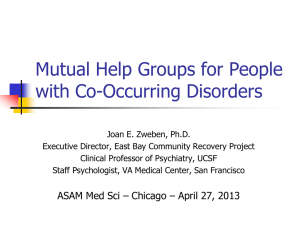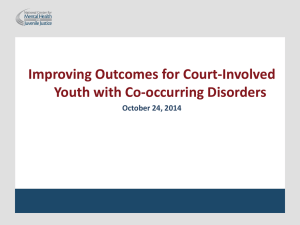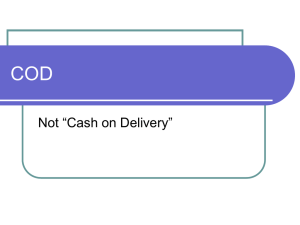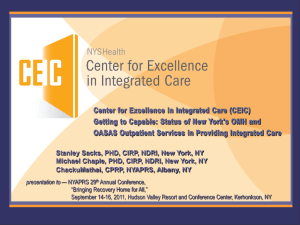(COD)?
advertisement
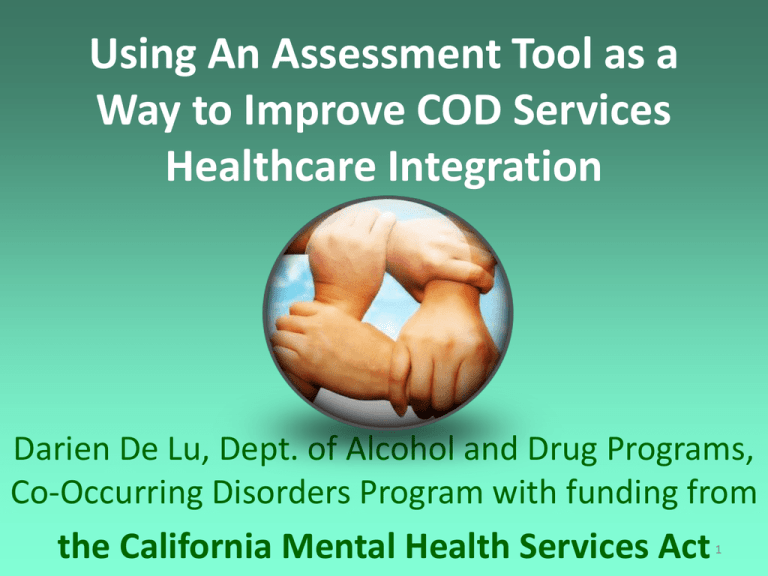
Using An Assessment Tool as a Way to Improve COD Services Healthcare Integration Darien De Lu, Dept. of Alcohol and Drug Programs, Co-Occurring Disorders Program with funding from the California Mental Health Services Act 1 Financial challenges bring a treatment crisis which demands a response… 2 Under healthcare reform, new pressure for substance abuse (SA) and mental health (MH) tx to integrate with primary medical care. • SA and MH issues drive health care costs, making integration with primary care all the more cost effective. • Chronic and relapsing conditions – including SA and MH – especially call for a continuing care model. 3 A Continuing Care Model Primary Care Specialty Care Primary Continuing Care 4 Preparing for a Changing System What will help us develop a successful continuing care model, with the high quality treatment that can attract the cooperation of primary care providers required under health care reform (HCR) – especially for a relapsing illness like Co-Occurring Disorders (COD)? 5 Use of the DDCAT or DDCMHT (Dual Diagnosis Capability in Treatment – Addiction or Mental Health) assessment tools can support improved treatment for COD, including both integrated tx and continuing care. 6 Integrated Treatment and Treatment Integration • Under Parity legislation and HCR – and to achieve savings – Federally Qualified Health Care Homes and others will emphasize integration of medical tx with AOD and MH tx. • SAMHSA and others recommend integrated AOD and MH tx for COD. 7 Why use the DDCAT/DDCMHT? • Use of the these assessment tools presents programs with information on quality COD tx in a format that allows and encourages improvement. • The workforce development and other tx improvements that the DDCAT/MHT encourage can help providers prepare for Health Care Reform changes. 8 What is COD? COD used to be the same as “dual diagnosis” (DD), referring only to SA combined with MH issues. Now – under HCR – the definition is expanding to refer to co-occurring chronic medical conditions, such as diabetes, asthma, and HIV. 9 Old COD and New COD • Many of those with DD – the “old COD” – also have chronic medical conditions, the “new COD”. • For this presentation, “COD” will refer to the “old COD” of DD . But the “new COD”, including DD, is critical to address for cost control in HCR and integrated health care! 10 How widespread are COD? • Approximately one-half of the people who have a MH or a SA disorder also have the other COD/DD condition. (SAMHSA statistic). • Partly due to poor management of chronic medical conditions, those with COD live 20 years fewer than average. 11 Examples of COD • Teen experiences long-term depression over parents’ divorce; to keep weight down “purges” (bulimia nervosa) then takes methamphetamines and drinks alcohol to feel better. • Iraq vet returns home with visions of friends blown up in war; is socially isolated & seriously depressed, drinks until blacks out, and has attempted suicide twice. 12 Integrated COD Treatment SAMHSA recommends integrated treatment for those with COD: Integrated Treatment = Simultaneous and Co-ordinated (usually, via case management) SA Treatment and MH Treatment 13 Past Year Treatment Among Adults with Co-occurring Serious Psychological Distress and Substance Use Disorder Treatment for Both Mental Health and Substance Use Problems 8.5% Treatment Only for Mental Health Problems Substance Use Treatment Only 4.1% 34.3% 53.0% No Treatment (SAMHSA, 2006) 14 “Availability of comprehensively integrated treatment for mental health and substance abuse problems is currently the exception rather than the rule. The unmet need for integrated mental health, alcohol and drug abuse treatment in underserved racial and ethnic communities is even greater.” California Mental Health Services Oversight and Accountability Commission (MHSOAC) Report on COD 15 Costs of Untreated or Improperly Treated COD • Medicaid (a driver in HCR) • Children’s and Adult Protective Services • CA Dept. of Corrections & Rehabilitation, (as high as 80% of substance abuse clients are assessed to have COD - State survey), county jails, juvenile hall • Education (increased demands on system) • Housing, homeless shelters • Foster Care system (parents with COD) 16 COD Clients Experience Poorer Outcomes: Persons with COD “have more medical problems, poorer treatment outcomes, greater social consequences and lower quality of life.” (MHSA Report) • One study of 121 clients with psychoses found that those with substance abuse problems (36%) spent twice as many days in the hospital over the 2 years prior to treatment as clients without these problems (Crome 1999; Menezes et al. 1996). 17 Additional Co-Occurring Conditions • COD clients also often have other poorer outcomes, such as higher rates of – – HIV infection – relapse – depression – suicide risk – rehospitalization (Office of the Surgeon General 1999, Drake et al. 1998) 18 Primary Care Screen Intervene Monitor Refer relapse Continuing Care for COD: Relapsing Specialty Care: Integrated MH & AOD Tx Stabilize Motivate/Medicate Train Self-Management Re-Intervene Continuing Care & Other Services Monitor/Support 19 The DDCAT/MHT Assesses Capability in COD Tx, Emphasizing Integrated Tx An easy-to-use fidelity instrument that – • Focuses on evidence-based practices • Allows a program to see where its services fit among specific better and worse practices. • Provides a baseline for future assessments. • Encourages, through its structure and modeling, improvements and Action Plans. 20 Quality COD Treatment Meshes Well with HCR • A welcoming, supportive, culturally sensitive, and structured program • Identifying COD clients by use of screening tools and, as indicated, appropriate assessment • Tx plans that are integrated and coordinated for both SA & MH tx 21 Quality COD Treatment & HCR, cont. • A trained workforce of skilled direct care staff/counselors to do assessments, tx plans, and tx that meets client needs • Building collaborative partnerships to access professionals to program supplement staff 22 Quality COD Treatment & HCR, cont. • COD tx policies and procedures in place • Continuity of Care throughout tx and upon discharge, including encouragement of support groups. • After-care resources and referral for both diagnoses 23 Program Response to the Use of the DDCAT Survey “I would recommend this process to any AOD treatment facility who wants to enhance or support their process in dealing with those with co-occurring disorders.” Program Director, one Pilot Project facility 24 You Can Encourage the Use of the DDCAT/MHT! • Inform programs: They can voluntarily do a DDCAT/ DDCMHT self-assessment. Download the free tool at the COD site: http://www.adp.ca.gov/COD/ddcat.shtml • After self-assessment, programs can use the resulting information to create their own Action Plan = Better COD Tx, Lower Healthcare Costs 25 Training in the DDCAT & DDCMHT • These tools can be usefully employed without further training. However, training in them is helpful both – – to obtain accurate results and – to reinforce the DDCAT/MHT information on components of quality tx capability. • The COD DDCAT website features DDCAT training materials for you to download. The two tools are extremely similar, so that training in one generally applies to the other. 26 The Goals: Improved COD Treatment, Better Preparation for HCR COD is a serious and wide-spread relapsing condition entailing substantial impacts on public services, so treatment improvements call for a continuing and integrated care approach to integrated tx, like the DDCAT and DDCMHT model. YOU CAN MAKE A DIFFERENCE! 27 The beginning of wellness for all! For further info, contact DDeLu@adp.CA.gov or KFurey@adp.CA.gov http://www.adp.ca.gov/COD/ddcat.shtml 28
